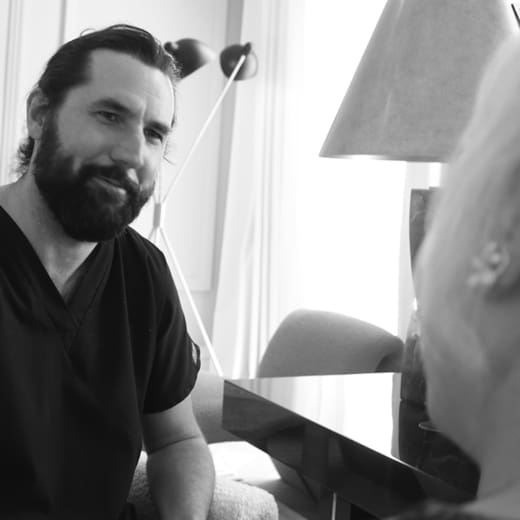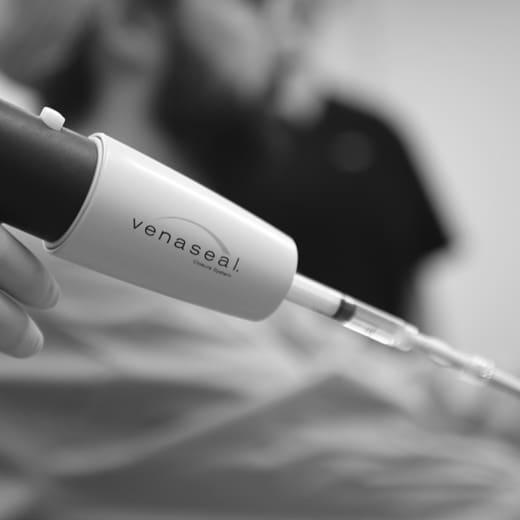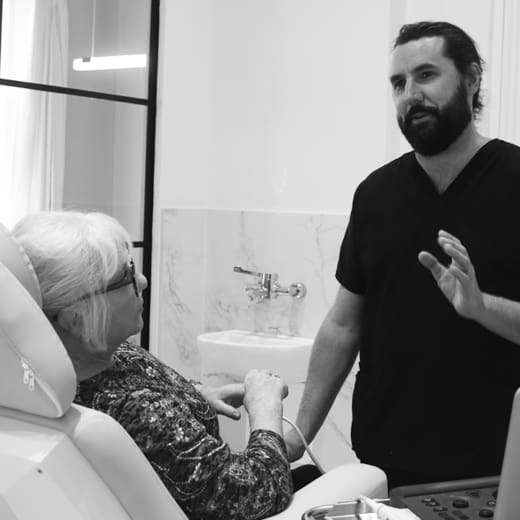McKeown Medical
167 Bath Street, Glasgow, G2 4SQ
Radiofrequency ablation (RFA) and endovenous laser ablation (EVLA) are two minimally invasive treatments used to effectively treat varicose veins, but what’s the difference?
Date posted — 29.09.24
Radiofrequency ablation (RFA) and endovenous laser ablation (EVLA) are two minimally invasive treatments used to effectively treat varicose veins. Both procedures aim to close off problematic veins, preventing them from causing further symptoms and leading to their eventual absorption by the body.
RFA uses radiofrequency energy to generate heat within the vein. A thin catheter is inserted into the vein through a small incision, and once inside, the radiofrequency energy is delivered through the catheter, causing the vein walls to heat up, collapse, and seal shut. This treatment is performed under local anaesthetic, and most patients experience little discomfort, with a quick recovery time and minimal scarring.
EVLA works on a similar principle but uses laser energy instead of radiofrequency to achieve the same result. During EVLA, a laser fibre is guided into the affected vein, and when activated, the laser’s heat damages the vein walls, causing them to collapse and close off.
Like RFA, EVLA is performed under local anaesthetic and is considered highly effective for treating varicose veins. Both RFA and EVLA offer excellent outcomes with low risk of complications, making them preferred options over more invasive surgical treatments. These procedures allow patients to resume normal activities relatively quickly, with significant improvement in both the appearance of the legs and the symptoms associated with varicose veins.

Although RFA and EVLA are very similar in terms of success rates at shutting down larger varicose veins, several studies have suggested that RFA may be associated with lower complication rates, so RFA is our preferred traditional endovenous method.
An even newer endovenous technique known as Venaseal™, however, is an exciting addition to our practice. The success rate of Venaseal™ is similar to both RFA and EVLA. However, it uses glue rather than heat to close the veins and is associated with even less discomfort.
The benefits of RFA for treating varicose veins are numerous, making it a popular choice for both patients and doctors. RFA is minimally invasive, requiring only a small incision to insert a catheter into the affected vein. This results in less pain, minimal scarring, and a quicker recovery time compared to traditional surgical methods.
The procedure is typically performed under local anaesthetic, reducing the risks associated with general anaesthetic. RFA is highly effective, with a success rate of over 90%, and provides long-term relief from the symptoms of varicose veins, such as pain, swelling, and leg fatigue. Additionally, patients can usually return to their normal activities within a day or two, making it a convenient option for those looking for an effective and efficient treatment.
Dr Alex Vesey is our expert consultant vascular surgeon who heads up our varicose vein team. Listen to him explain the Radiofrequency Ablation (RFA) treatment.

RFA is considered better than EVLA for treating varicose veins in our practice because it’s generally a more comfortable experience and has a lower risk of complications.
RFA typically causes less post-procedural pain and bruising because it uses radiofrequency energy, which generates a gentler heat compared to the intense heat from laser energy used in EVLA. This can result in a smoother recovery with less discomfort for patients.
Additionally, RFA has a slightly lower risk of nerve damage, particularly in areas where veins are close to nerves, such as the lower leg. The procedure’s outcomes are highly successful and comparable to EVLA but with a more favourable side effect profile, making RFA a preferred option for many patients and clinicians.
Recently, we have introduced the Venaseal™ procedure. Venaseal™ is even less invasive because it avoids the use of heat altogether, which causes even less discomfort whilst still achieving excellent closure rates and long-term outcomes for patients.
If you’d like to find out if RFA is the right treatment for you, the first step is to fill out our online consultation form. From there, our team will be able to arrange an initial consultation and ultrasound scan, and we can work together to create a treatment plan that is tailored to your needs.

If you're struggling with the discomfort, swelling, or unsightly appearance of varicose veins, Radiofrequency Ablation (RFA) could be the solution...

When it comes to treating varicose veins, VenaSeal™ has emerged as a revolutionary option that offers a minimally invasive and...

Varicose veins are enlarged, twisted veins that often appear just under the skin, primarily in the legs and feet.
1 / 3
2 / 3
3 / 3

If you're struggling with the discomfort, swelling, or unsightly appearance of varicose veins, Radiofrequency Ablation (RFA) could be the solution...

When it comes to treating varicose veins, VenaSeal™ has emerged as a revolutionary option that offers a minimally invasive and...

Varicose veins are enlarged, twisted veins that often appear just under the skin, primarily in the legs and feet.
Laser rejuvenation of the eye area can be an incredibly powerful tool for the right patients, especially those whose ‘bags’ are more about loose skin and fine lines, like this lovely patient here.
We treated her with full field ablation, which takes around 2 weeks to recover from. Her she is a few weeks later and you can see how much tighter the skin is, the crepey skin has gone and the fine lines have been ironed out. The patient is over the moon.
What do you think?

Eyelid surgery is one of the most popular procedures we do in the clinic. It’s a great fix for hooded eyes! Excess skin on the upper eyelids can not only create a hooded, heavy appearance but often affects the vision too.
Here’s the very talented @bramhallplasticsurgery discussing how upper eyelid surgery (blepharoplasty) can restore a more open, refreshed look by removing the excess skin and subtly redefining the natural eyelid crease. Scars are hidden within the fold of the eyelid, leaving eyes that look brighter, not “done.”
Do you have any questions about surgery? Ask in the comments or send us a message!

Thank you to our patient for allowing us to share her before and after photos of her upper blepharoplasty.
Excess skin on the upper eyelids can make the eyes appear tired or heavy. This simple procedure restores a lighter, more open look while keeping the result completely natural.
Another fabulous result from the very talented @bramhallplasticsurgery!
What do you think?

We’ve been in our new home for a year now and I thought this would be a good time to remind you just how special it is with a little video tour.
It’s been a remarkable year for us in our new home; we’ve introduced new doctors, new treatments, new services and our team continues to grow from strength to strength - always striving to provide more and better for our wonderful patients.
Enjoy the tour!

About last night… It was time once again for our annual Christmas celebration with this absolute bunch of legends. We were a little earlier than usual this year so we could have has many people available as possible, and the evening did not disappoint.
A few sore heads this morning, but absolutely worth it to celebrate the hard work this team dedicate to our patients day in, day out all year round. I am very proud to have the undisputed best team on the planet. Merry Christmas everyone! 🎄

Fine lines etched into the skin around the mouth - this is a common problem and in this patient`s case she had what we call ‘actinic elastosis’, whereby abnormal bands of elastin build up in the skin as a result of years of previous sun exposure.
When patients have this condition, the gold standard way of dealing with it is fully ablative laser resurfacing. It’s an intense treatment with two weeks of downtime afterwards, but the results are spectacular - just like in this lovely patient.
The after photo is three weeks after the treatment and you can see that the skin is still a little pink, which will continue to fade over the next few months.
The patient is already delighted with the result - what do you think?

It’s beginning to look a lot like Christmas!
At least according to Michael Buble, who’s been on repeat in the clinic this week. The decorations are up and we are officially in ‘our season’. The clinic has been packed with everyone having their skin polished in time to make it on the nice list. If you’ve still to make a pre-Christmas appointment, we’ve still got some spaces left for your festive glow up.
Ho ho ho everyone… It’s time for Santa!!!! 🎅🏻

Ok, so this is the one we’ve all been waiting for. Sofwave : the results, in our hands!!!
This is the first patient we treated with @sofwave.uk when we were assessing the machine and deciding whether or not to buy it. These are the patient`s own photos that she kept throughout the healing journey.
Now do you see why we are so excited?! 🤩
#sofwave
#sofwavemed
#SUPERB
#sofwavemedical
#sofwavejourney
#sofwaveexperience

We are now well up and running with @sofwave.uk , much to the excitement of the whole team in the clinic (we are all queuing up to get a shot!)
This is a little video of the treatment being performed, so you can see what the process is like and there is even a little early preview of the results at the end.
One of the best parts is that there is no downtime, so we can still fit it in before Christmas without worrying about redness in the party season!
What do you think?
#sofwave
#sofwavemed
#SUPERB
#sofwavemedical
#sofwavejourney
#sofwaveexperience
